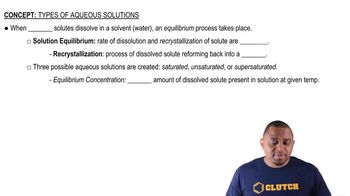(a) Based on the following energy profile, predict whether kf > kr or kf < kr. [Section 15.1]
Consider the equilibrium Na2O(s) + SO2(g) ⇌ Na2SO3(s). (a) Write the equilibrium-constant expression for this reaction in terms of partial pressures. (b) All the compounds in this reaction are soluble in water. Rewrite the equilibrium-constant expression in terms of molarities for the aqueous reaction.
 Verified step by step guidance
Verified step by step guidanceKey Concepts
Equilibrium Constant Expression

Le Chatelier's Principle

Solubility and Aqueous Equilibria

The following diagrams represent a hypothetical reaction A ¡ B, with A represented by red spheres and B represented by blue spheres. The sequence from left to right represents the system as time passes. Does the system reach equilibrium? If so, in which diagram(s) is the system in equilibrium? [Sections 15.1 and 15.2]
The following diagram represents a reaction shown going to completion. Each molecule in the diagram represents 0.1 mol, and the volume of the box is 1.0 L. (d) Assuming that all of the molecules are in the gas phase, calculate n, the change in the number of gas molecules that accompanies the reaction. [Section 15.2]
Ethene (C2H4) reacts with halogens (X2) by the following reaction:
C2H4(𝑔) + X2(𝑔) ⇌ C2H4X2(𝑔)
The following figures represent the concentrations at equilibrium at the same temperature when X2 is Cl2 (green), Br2 (brown), and I2 (purple). List the equilibria from smallest to largest equilibrium constant. [Section 15.3]
